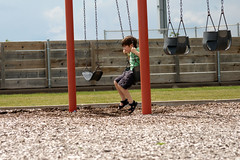 This morning the Washington Post is running a story about a new study out of the Pew Charitable Trusts Economic Mobility Project, offering a more nuanced understanding of the forces affecting the income outcomes they documented in a project completed several years ago — “that nearly half of African American children born to middle-class parents in the 1950s and ’60s had fallen to a lower economic status as adults, a rate of downward mobility far higher than that for whites.”
This morning the Washington Post is running a story about a new study out of the Pew Charitable Trusts Economic Mobility Project, offering a more nuanced understanding of the forces affecting the income outcomes they documented in a project completed several years ago — “that nearly half of African American children born to middle-class parents in the 1950s and ’60s had fallen to a lower economic status as adults, a rate of downward mobility far higher than that for whites.”
But why? The answer is at least in part due to geographic location. The Pew Center’s new research suggests that “being raised in poor neighborhoods plays a major role in explaining why African American children from middle-income families are far more likely than white children to slip down the income ladder as adults.”
The new study:
This week, Pew will release findings of a study that helps explain that economic fragility, pointing to the fact that middle-class blacks are far more likely than whites to live in high-poverty neighborhoods, which has a negative effect on even the better-off children raised there. The impact of neighborhoods is greater than other factors in children’s backgrounds, Pew concludes.
Even as African Americans have made gains in wealth and income, the report found, black children and white children are often raised in starkly different environments. Two out of three black children born from 1985 through 2000 were raised in neighborhoods with at least a 20 percent poverty rate, compared with just 6 percent of white children, a disparity virtually unchanged from three decades prior.
Even middle-class black children have been more likely to grow up in poor neighborhoods: Half of black children born between 1955 and 1970 in families with incomes of $62,000 or higher in today’s dollars grew up in high-poverty neighborhoods. But virtually no white middle-income children grew up in poor areas.
Using a study that has tracked more than 5,000 families since 1968, the Pew research found that no other factor, including parents’ education, employment or marital status, was as important as neighborhood poverty in explaining why black children were so much more likely than whites to lose income as adults.
A sociologist authored this new report…
Patrick Sharkey, the New York University sociologist who wrote the report, said researchers still need to pinpoint which factors in neighborhoods matter most, such as schools, crime or peer groups. But overall, he said, the impact of the contrasting surroundings for black and white children was indisputable.
“What surprises me is how dramatic the racial differences are in terms of the environments in which children are raised,” he said. “There’s this perception that after the civil rights period, families have been more able to seek out any neighborhood they choose, and that . . . the racial gap in neighborhoods would whittle away over time, and that hasn’t happened.”
And other scholars offered feedback…
Ideally, said several scholars who read the report, investments in struggling neighborhoods would improve them to the extent that the middle-income families would not feel the need to leave.
“These findings do suggest that those with the means or resources should try to escape these neighborhoods,” said Harvard sociologist William Julius Wilson. “But . . . the exodus of middle-class families from poor black neighborhoods increases the adverse effects of concentrated poverty.”
Read more.





